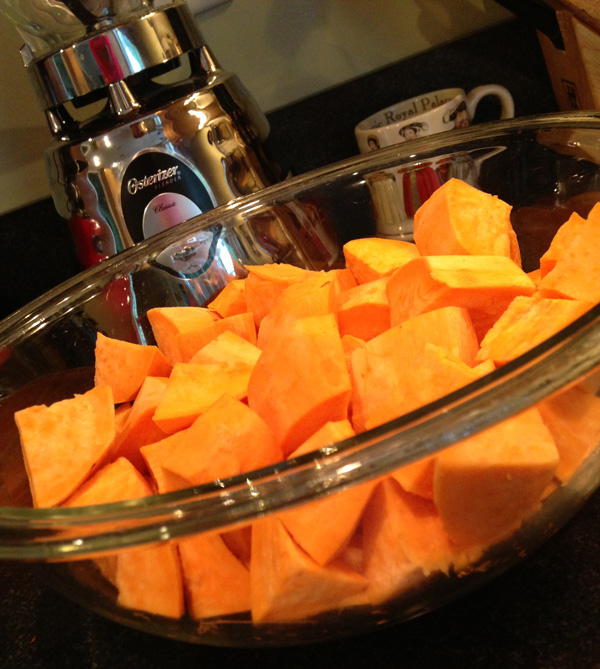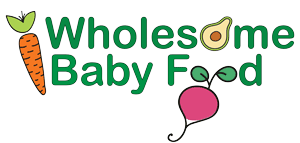
If there is one thing that may be missing in The Wholesome Baby Food Guide book, it’s instructions for how to cook each recipe in the microwave.
I believe in baking, roasting, sauteing, or steaming the foods that I feed to my family. Now please, don’t feel like you should tell me to take off my tinfoil hat (and tinfoil should never be used in the microwave – safety reminder!) because really, I don’t believe that the microwave will short circuit and/or re-wire my brain, fry my ovaries and/or cause my eyeballs to melt.
There are many “studies” that have been done claiming that microwaves will kill you, fry your internal organs, deplete all the nutrients from foods etc and so on. Other studies show that microwave cooking actually helps retain nutrients in many foods and show that microwave cooking is 100% safe. Most of the dangers, if you please, can come from using the wrong containers when cooking in the microwave. Even in 2013, there are still no reputable longitudinal studies that have been published that show that microwave cooking is or is not harmful.
I believe that the healthiest way to cook foods is by using the methods that people have been using for centuries, all the way back to when fire was first created and cooking vessels were crafted.
Baking or roasting foods is my first preference. Using dry heat, food is cooked evenly and retains the most nutrients and, the full spectrum of a food’s flavor is enhanced and brought out. Steaming foods is also a great way to cook a large amount of foods while at the same time retaining nutrients.
I don’t include many microwave instructions quite simply because microwave cooking is mostly inefficient when cooking for a family and is often done using the wrong types of bowls or trays or whatever people use to microwave their foods. Think about this:
- How easy it is to roast a whole chicken. leg of lamb or beef roast in the microwave?
- Have you ever tried to microwave a 3 pound butternut squash?
- How about batch cooking; when was the last time you were able to cook 4 sweet potatoes, 2 butternut squashes and 3 apples into your microwave?
I use the microwave for heating up my morning coffee, hot coco or other small items like reheating soup or a black bean burger. If I am pressed for time, I will cook swet potatoes or other veggies in the microwave too. This is just the way I do it and the way I feel about using the microwave. So without further ado, here are some microwave cooking hints and tips for homemade baby food.
Safely Cook in the Microwave:
- Always cook foods in glass dishes or on glass plates.
- Never wrap foods in plastic wrap and then cook the foods
- Never use cheap plastic containers to cook in the microwave – they melt and melting plastic is not good for your baby or for any member of the family!
- Keep aluminum and steel out of the microwave as they can cause sparks and result in fires
I have found that these methods work best when you are using the microwave to cook foods:
- When cooking sweet potatoes or even white potatoes, wet them and then poke holes in them with a fork – the moisture helps keep the foods moist and helps to speed cooking (as is my experience)
- Peel and cube or chop & dice foods like apples, potatoes, butternut squash, peaches, carrots etc
- Do not soak foods in a cooking liquid such as water, a little water will go a long way. For example, use a 1/4 cup water for 2 cups of chopped carrots
- Cooking times will always vary so begin with a 5 or 10 minute interval and then continue cooking the food in intervals
- Use a glass plate to cover the glass dish you are cooking in so that eruptions don’t dirty your microwave and the heat is trapped to help faster cooking
- To cook meats for baby food, cube the meat and then add in a bit of water to help retain tenderness
- Always allow any food or liquid that you have cooked or heated in the microwave to cool before serving.
- Thoroughly stir foods to avoid any “hot spots” that could cause burns
Microwave Sweet Potato Puree for Babies – Peeled and Cubed
- 1 Large Sweet Potato
- 1/2 to 1 cup of water
- 1/4 tsp. cinnamon (optional)
- drip of vanilla (optional)
- Wash and scrub the sweet potato clean
- Peel sweet potato
- Cut sweet potato into 1 inch chunks
- Place sweet potato chunks in a large glass microwaveable cooking dish
- Pour water over sweet potatoes and add spices if using, stir to combine
- Cover dish with glass plate
- Microwave for 10 minutes on high
- Check sweet potatoes and continue to cook at 5 minute intervals until sweet potatoes are soft and tender.
Microwave Sweet Potato Puree for Babies – Peeled and Cubed
- 1 Large Sweet Potato
- 1/2 to 1 cup of water
- 1/4 tsp. cinnamon (optional)
- drip of vanilla (optional)
- Wash and scrub the sweet potato clean
- Peel sweet potato
- Cut sweet potato into 1 inch chunks
- Place sweet potato chunks in a large glass microwaveable cooking dish
- Pour water over sweet potatoes and add spices if using, stir to combine
- Cover dish with glass plate
- Microwave for 10 minutes on high
- Check sweet potatoes and continue to cook at 5 minute intervals until sweet potatoes are soft and tender.
When using the microwave, here are some tips from Harvard Medical School Health Publications :
- Most takeout containers, water bottles, and plastic tubs or jars made to hold margarine, yogurt, whipped topping, and foods such as cream cheese, mayonnaise, and mustard are not microwave-safe.
- Microwavable takeout dinner trays are formulated for one-time use only and will say so on the package.
- Don’t microwave plastic storage bags or plastic bags from the grocery store.
- A recycle symbol does not mean a container is safe to use or reuse in the microwave oven. Only a microwave-safe icon or wording to that effect does.
- Before microwaving food, be sure to vent the container: Leave the lid ajar, or lift the edge of the cover.
- Don’t allow plastic wrap to touch food during microwaving because it may melt. Wax paper, kitchen parchment paper, or white paper towels are alternatives.
- If you’re concerned about plastic wraps or containers in the microwave, transfer food to glass or ceramic containers labeled for microwave oven use.
